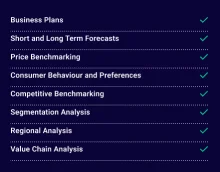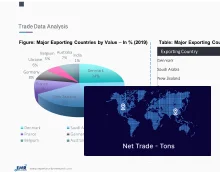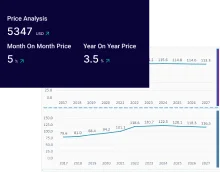
Consumer Insights
Uncover trends and behaviors shaping consumer choices today
Procurement Insights
Optimize your sourcing strategy with key market data
Industry Stats
Stay ahead with the latest trends and market analysis.
Trending Now



The manufactured housing market size reached around USD 24.42 Billion in 2024. The market is projected to grow at a CAGR of 5.80% between 2025 and 2034 to reach nearly USD 42.91 Billion by 2034.
Base Year
Historical Period
Forecast Period






Value in USD Billion
2025-2034
Manufactured Housing Market Outlook
*this image is indicative*
Read more about this report - REQUEST FREE SAMPLE COPY IN PDF
| Manufactured Housing Market Report Summary | Description | Value |
| Base Year | USD Billion | 2024 |
| Historical Period | USD Billion | 2018-2024 |
| Forecast Period | USD Billion | 2025-2034 |
| Market Size 2024 | USD Billion | 24.42 |
| Market Size 2034 | USD Billion | 42.91 |
| CAGR 2018-2024 | Percentage | XX% |
| CAGR 2025-2034 | Percentage | 5.80% |
| CAGR 2025-2034 - Market by Region | Asia Pacific | 7.5% |
| CAGR 2025-2034 - Market by Country | India | 8.6% |
| CAGR 2025-2034 - Market by Country | Canada | 7.2% |
| CAGR 2025-2034 - Market by Location | MH Communities | 6.1% |
| CAGR 2025-2034 - Market by Application | Residential | 6.6% |
Manufactured housing refers to prefabricated houses that are built and assembled in factories and later transported to the site of use. They are also referred to as mobile homes and their cost of construction is considerably lower than that of traditional houses.
Growing demand for sustainable housing is boosting the growth of manufactured housing market as builders incorporate energy-efficient materials in the construction of modular houses. Walls and roofs of modular houses are built with insulated material to reduce heat loss and leftover scraps are often reused in the building process to reduce the waste.
The introduction of several government initiatives and programmes aimed at increasing funding and promoting prefabricated housing solutions, especially in regions facing housing shortages and high costs of standard houses, is a crucial trend of manufactured housing market anticipated to aid the market in the coming years.
Increased incorporation of smart home technology such as smart thermostats to optimise the heating and cooling for energy efficiency, security features such as intelligent alarms and remote-controlled locks, and smart lighting to adjust the intensity of light and save energy provides impetus to the market predictions growth.
One of the key updates is the extensive revision to the HUD Code, which governs manufactured home construction and safety standards. As per the manufactured housing market dynamics and trends, these changes, announced by the U.S. Department of Housing and Urban Development (HUD), include 90 new or updated standards aimed at making manufactured homes more modern, energy-efficient, and affordable.
Rising Demand for Affordable Housing Supports the Growth of the Global Manufactured Housing Market
According to the United States Census Bureau, from 2019 to 2024, the shipments of new manufactured homes in the United States demonstrated several trends. In 2019, the total number of shipments was 94.6 thousand units and in 2020, 94.4 thousand units were shipped. In 2021, shipments reached 105.8 thousand units, which boosts the growth of the manufactured housing industry. This upward trend continued in 2022, with shipments totaling 112.9 thousand units. The year 2023, however, showed a decline, with 89.2 thousand units shipped. The preliminary data for 2024 suggests a potential rebound, with 42.7 thousand units shipped in just the first five months, indicating a possible return to growth.
From 2017 to 2022, the market volume of prefabricated housing across various European countries experienced notable growth. The United Kingdom exhibited a compound annual growth rate (CAGR) of 3.8% from 2017 to 2022, contributing to the manufactured housing industry revenue. Poland showed significant growth, with a CAGR of 6.9% from 2017 to 2022. Scandinavia experienced a CAGR of 3.5% from 2017 to 2022 while Germany grew by 3.1% from 2017 to 2022. By 2022, the total market volume of prefabricated housing reached 70.1 thousand units, up from 62.3 thousand units in 2018. The global market is influenced by these trends, with an increasing number of countries adopting prefabricated and modular homes to meet housing demands efficiently.
Number of Section Insights
On the basis of the number of section segments, there are ideally four types that have boosted the manufacturing house market. These include single section, double section, multi section, and park models. Single section homes are the simplest homes, consisting of one single, compact unit that is affordable and helpful for small families. They’re also generally easier and faster to set up, which makes them an ideal option among budget-conscious buyers. Double section homes provide extra space for families within the evolving definition of affordable housing.
Multi-Section homes are the biggest in this category. These merge several sections to form roomy living spaces. The manufacturing house market is also seeing a surge in demand, thanks to park models. These are for use in recreation areas and are actually mobile homes, like the ones you see commonly in resort type communities.
Construction Material Insights
The construction material segment is significantly impacted on the quality, price and environmental friendliness of prefabricated houses. Wood, one of the most traditional materials, is extensively used in framing and finishing. It particularly gives gym space an organic look, and it is low-cost to use in the short run, although it might require high maintenance in the long run compared to other materials. Consumers, in increasing numbers, have preferred wood-based homes because of their versatility and insulation.
Steel, by contrast, is seeing increased demand, due to its strength and sturdiness and its resistance to environmental factors like rot, pests and fire. Steel-framed homes also offer more structural integrity for areas that experience intense weather. Furthermore, modular construction uses prefabricated panel and component systems. Modern alternatives ensure faster build times and precise manufacturing processes. To strike this balance between strength, sustainability, and efficiency, many modular homes utilize a handful of different materials, including steel and wood.
Location Insights
The appeal of location significantly boosts the manufactured housing market. Location depends on attractiveness, cost, and lifestyle greatly. Private property is one of the most demanded manufactured homes where the purchasers acquire land along with the property. End users experience more flexibility, seclusion, and authority on the property compared to other kinds of properties. Therefore, many prefer private property since it is ideal for gaining autonomy and a wider living area. Private property also enables individuals to alter or increase their dwelling to suit them as they choose.
Manufactured home communities (MH communities) offer an alternative by placing manufactured homes in a specific location with shared amenities and a sense of community. These usually have less to maintain since the land belongs to the group itself while providing common use of a park, clubhouses, and security services, less detailed, and more option by a person. This type of property is ideal for those looking for a more socially oriented experience with shared amenities available.
Application Insights
The manufactured housing market is broadly segmented into four applications, including residential, non-residential, recreational and commercial. The residential segment has dominated the market with the largest share. In this segment, manufactured homes are used as primary homes for individuals and families. They are built with the intention of being long-term, cost-efficient housing, making them an attractive option for those looking for a more budget-friendly solution than traditional homes.
Non-residential applications include storage units, office buildings, or any temporary structure. These houses can be even converted according to the demands of industries, offering suitable rental space. Further, residential applications have responded to the rising demand for holiday homes or temporary accommodation such as in parks or resorts. These are often used seasonally or sporadically, designed for mobility and short-term living comfort. The commercial category includes the use of manufactured homes at business locations or companies; they are excellent for use as service centers, construction sites, retail locations, or remote offices, as they can be set up quickly and cost-effectively.
Size Insights
To accommodate a variety of preferences and needs, manufactured homes come in a broad range of sizes. For singles or couples seeking a basic, affordable living place, small homes—typically less than 700 square feet—are ideal. These tiny homes are frugal and reasonably priced, providing the ideal amount of space for the necessities without the additional upkeep costs associated with larger residences.
The medium-size homes (700 to 1,500 square feet) are the ideal size, between small homes and homes desired by small families or consumers needing more room. Manufactured housing is well-suited for individuals who want additional bedrooms or a second living area, or who might prefer a more spacious home at a lower than average price point. Large homes, defined as those larger than 1,500 square feet with ample living space, bedrooms and common areas. They are perfect for larger families, with the same comfort and luxuries associated with traditional homes but at a much lower price point.
Price Range Insights
Elaborate manufactured homes are widely available at extensive price points dependent upon their size, location, material, and so forth. Low-cost manufactured homes are notably smaller, basic units with price points up to USD 100,000 that serve as economical housing for larger needs, smaller couples, and those on a budget. These homes are usually simple in design, offering only the necessities, without any additional features, which makes them attractive to first-time home-buyers or consumers looking to reduce housing expenses.
The cost of average properties, which lie between USD 100,000 to USD 150,000, offer more features for buyers. These homes include higher-quality materials, more square footage and greater customization rates, catering to consumers seeking more comfort and functionality while remaining cost-conscious. Houses that have a sale price greater than USD 150,000 are generally bigger with higher-end features and finishes, such as upgraded appliances and construction methods. These homes cater to buyers looking for more upscale manufactured housing that is larger and more amenity-filled, allowing them to compete with traditional homes in comfort and style.
North America Manufactured Housing Market Trends
In recent years, there has been a growing need for affordable housing throughout North America leading to an increase in demand for manufactured housing. The market is expected to witness a fast rate on account of increasing prices of conventional houses and their deficiency in the region. As property prices in cities keep going up, many buyers are considering manufactured homes as an affordable option. This trend has also been especially pronounced in rural and suburban pockets of homebuilding, as manufacturers tried to meet the new homebuyer preferences with a greater range of customization and energy-saving designs as real estate space becomes more readily available.
Europe Manufactured Housing Market Trends
There is growing the use of factory-made homes as a solution to the housing crisis in the UK and increasingly all over Europe. Demand is driven largely by value for money and sustainability. Potential purchasers are increasingly keen to explore alternatives to bricks and mortar homes especially in hot property markets where land prices are high. In Scotland and Wales, where planning rules are more lenient, manufactured homes are an attractive option.
Asia Pacific Manufactured Housing Market Trends
The manufactured housing market in Asia Pacific is growing due to rapid urbanization and a broad increase in populations in countries like China, India, and Japan. With the rising need for affordable housing, manufactured homes are becoming an attractive low-cost, quick-to-build housing solution. Moreover, the trend of having more compact living spaces and efficient lifestyle, the market will continue to grow.
Latin America Manufactured Home Market Trends
The Latin American market for manufactured housing is rapidly expanding, as governments seek affordable housing options for the low-income population. Manufactured homes represent a faster, more economical solution to building houses, urban or rural, meeting the housing needs that have been raised in some of the hardest hit areas like Brazil and Mexico. Low cost and flexibility have proven attractive and manufactured homes have become an attractive choice for many home buyers.
Middle East and Africa Manufactured Housing Market Trends
With urbanization on the rise, the market for manufactured homes in the Middle East & Africa is emerging as the solution to the need for affordable, short-term accommodation. Such projects are more common in places like South Africa and the United Arab Emirates, for low-income housing, rural locations, and worker modular homes. With the development of supporting infrastructure, manufactured housing is a swift and budget-friendly fix for housing requirements.
| CAGR 2025-2034 - Market by | Country |
| India | 8.6% |
| China | 7.2% |
| Canada | 7.2% |
| USA | 6.2% |
| Australia | 5.1% |
| UK | XX% |
| Germany | XX% |
| France | XX% |
| Italy | XX% |
| Japan | 4.5% |
| Saudi Arabia | XX% |
| Brazil | XX% |
| Mexico | XX% |
Cavco Industries, Inc., established in 1965 and based in Arizona, the United States, is a manufacturer of pre-made houses. The company provides budget-friendly housing solutions under brand names such as Fairmont Homes, and Fleetwood Homes, among others.
Champion Home Builders, Inc. is a modular or mobile houses company, incorporated in 1953 and headquartered in Michigan, the United States. It offers construction services for residential houses, hospitality, government, and remote workforce, among others.
Clayton Homes, Inc., founded in 1956, is a modular and manufactured housing company, with its headquarters in Tennessee, the United States. It provides the facility of personalising and styling prefabricated homes to the buyers.
*Please note that this is only a partial list; the complete list of key players is available in the full report. Additionally, the list of key players can be customized to better suit your needs.*
Other manufactured housing market players include Domino Homes, Skyline Champion Corporation, Karmod Prefabricated Technologies, General Coach Canada, Ironwood Manufactured Homes, Cumberland Japan Co., Ltd., and Knight Mobile Homes Ltd., among others.
Raw Material Costs
Fluctuations in the prices of raw materials such as lumber, steel, insulation, and other building materials directly impact the cost of modular housing.
Labour Costs
Wages and labour availability can affect the cost of producing manufactured houses, impacting the demand of manufactured housing market.
Energy Costs
The cost of energy required for manufacturing processes, including electricity and fuel, influences production expenses.
Transportation and Logistics Costs
The cost of transporting materials to manufacturing facilities and finished homes to their final destinations impacts overall pricing.
Regulatory Compliance Costs
Costs associated with meeting local, national, and international building codes and regulations, including safety and environmental standards, can affect the final price of manufactured homes.
Technological Advancements
Investments in new technologies and innovations in manufactured home construction processes can influence production costs.
Market Demand
Economic conditions, consumer preferences, and demographic trends influence manufactured housing demand growth.
Land Costs
The cost of land where manufactured homes are placed impacts overall affordability.
Competition
Intense competition may lead to price reductions, while limited competition can allow for higher pricing.
Consumer Confidence and Economic Conditions
General economic conditions and consumer confidence affect purchasing power and demand for manufactured homes.
Customization and Features
The level of customization and additional features offered in manufactured homes impact pricing and manufactured housing market value.
Affordability of Housing
As traditional housing becomes more expensive, the demand for more affordable alternatives like manufactured homes increases.
Economic Conditions
Overall economic health, including employment rates, wage growth, and consumer spending impacts the demand for manufactured housing.
Housing Shortages
In regions facing housing shortages, manufactured homes provide a quicker and often more affordable solution, driving up manufactured housing demand forecast.
Government Policies and Incentives
Government initiatives to promote affordable housing, including tax incentives, subsidies, and relaxed zoning laws, can significantly boost demand for manufactured homes.
Retirement and Aging Population
As the aging population grows, the demand for affordable, low-maintenance living options is expected to rise among retirement communities.
Natural Disasters and Emergency Housing Needs
Manufactured homes are often used as temporary or permanent housing solutions in the aftermath of natural disasters, leading to spikes in demand.
Environmental and Sustainability Concerns
Growing interest in sustainable living and eco-friendly construction can drive demand for sustainable and energy-efficient manufactured homes.
Environmental Regulations
Stricter environmental regulations on traditional home construction can make manufactured homes, which often have a smaller environmental footprint, a more attractive option.
The EMR’s report titled “Manufactured Housing Market Report and Forecast 2025-2034” offers a detailed analysis of the market based on the following segments:
Breakup by Number of Section
Breakup by Location
Breakup by Application
Breakup by Region
*While we strive to always give you current and accurate information, the numbers depicted on the website are indicative and may differ from the actual numbers in the main report. At Expert Market Research, we aim to bring you the latest insights and trends in the market. Using our analyses and forecasts, stakeholders can understand the market dynamics, navigate challenges, and capitalize on opportunities to make data-driven strategic decisions.*
Get in touch with us for a customized solution tailored to your unique requirements and save upto 35%!
The market size was approximately USD 24.42 Billion in 2024.
The market is projected to grow at a CAGR of 5.80% between 2025 and 2034.
The market is estimated to witness a healthy growth in the forecast period of 2025-2034, reaching a value of around USD 42.91 Billion by 2034.
The major market drivers are affordable construction costs and reduced time for completion required for manufactured housing, and a growing population.
Government initiatives to promote affordable housing, including tax incentives, subsidies, and relaxed zoning laws, can significantly boost demand for manufactured homes.
The major regions in the market are North America, Europe, the Asia Pacific, Latin America, and the Middle East and Africa.
Various locations are private property and MH communities.
Major companies leading the market are Cavco Industries, Inc., Champion Home Builders, Inc., Clayton Homes, Inc., Domino Homes, Skyline Champion Corporation, Karmod Prefabricated Technologies, General Coach Canada, Ironwood Manufactured Homes, Cumberland Japan Co., Ltd., and Knight Mobile Homes Ltd., among others.
Affordability, energy efficiency, and reduction in construction waste are some major factors boosting the market growth.
Manufactured homes are generally more affordable than traditional site-built homes, providing an accessible option for low- to middle-income families.
Explore our key highlights of the report and gain a concise overview of key findings, trends, and actionable insights that will empower your strategic decisions.
| REPORT FEATURES | DETAILS |
| Base Year | 2024 |
| Historical Period | 2018-2024 |
| Forecast Period | 2025-2034 |
| Scope of the Report |
Historical and Forecast Trends, Industry Drivers and Constraints, Historical and Forecast Market Analysis by Segment:
|
| Breakup by Number of Section |
|
| Breakup by Location |
|
| Breakup by Application |
|
| Breakup by Region |
|
| Market Dynamics |
|
| Competitive Landscape |
|
| Companies Covered |
|
Single User License
One User
USD 3,999
USD 3,599
tax inclusive*
Datasheet
One User
USD 2,499
USD 2,249
tax inclusive*
Five User License
Five User
USD 4,999
USD 4,249
tax inclusive*
Corporate License
Unlimited Users
USD 5,999
USD 5,099
tax inclusive*
*Please note that the prices mentioned below are starting prices for each bundle type. Kindly contact our team for further details.*
Flash Bundle
Small Business Bundle
Growth Bundle
Enterprise Bundle
*Please note that the prices mentioned below are starting prices for each bundle type. Kindly contact our team for further details.*
Flash Bundle
Number of Reports: 3
20%
tax inclusive*
Small Business Bundle
Number of Reports: 5
25%
tax inclusive*
Growth Bundle
Number of Reports: 8
30%
tax inclusive*
Enterprise Bundle
Number of Reports: 10
35%
tax inclusive*
How To Order
Our step-by-step guide will help you select, purchase, and access your reports swiftly, ensuring you get the information that drives your decisions, right when you need it.

Select License Type
Choose the right license for your needs and access rights.

Click on ‘Buy Now’
Add the report to your cart with one click and proceed to register.

Select Mode of Payment
Choose a payment option for a secure checkout. You will be redirected accordingly.
Track prices with detailed trend reports.

Analyse trade data for supply chain insights.

Leverage cost reports for smart savings

Enhance supply chain with partnerships.

Gain insights to stay ahead and seize opportunities.

Get insights & trends for a competitive edge.

Track prices with detailed trend reports.

Analyse trade data for supply chain insights.

Leverage cost reports for smart savings

Enhance supply chain with partnerships.

Gain insights to stay ahead and seize opportunities.

Get insights & trends for a competitive edge.

Track prices with detailed trend reports.

Analyse trade data for supply chain insights.

Connect For More Information
Our expert team of analysts will offer full support and resolve any queries regarding the report, before and after the purchase.
Our expert team of analysts will offer full support and resolve any queries regarding the report, before and after the purchase.
We employ meticulous research methods, blending advanced analytics and expert insights to deliver accurate, actionable industry intelligence, staying ahead of competitors.
Our skilled analysts offer unparalleled competitive advantage with detailed insights on current and emerging markets, ensuring your strategic edge.
We offer an in-depth yet simplified presentation of industry insights and analysis to meet your specific requirements effectively.



Australia
63 Fiona Drive, Tamworth, NSW
+61-448-061-727
India
C130 Sector 2 Noida, Uttar Pradesh 201301
+91-723-689-1189
Philippines
40th Floor, PBCom Tower, 6795 Ayala Avenue Cor V.A Rufino St. Makati City,1226.
+63-287-899-028, +63-967-048-3306
United Kingdom
6 Gardner Place, Becketts Close, Feltham TW14 0BX, Greater London
+44-753-713-2163
United States
30 North Gould Street, Sheridan, WY 82801
+1-415-325-5166
Vietnam
193/26/4 St.no.6, Ward Binh Hung Hoa, Binh Tan District, Ho Chi Minh City
+84-865-399-124
United States (Head Office)
30 North Gould Street, Sheridan, WY 82801
+1-415-325-5166
Australia
63 Fiona Drive, Tamworth, NSW
+61-448-061-727
India
C130 Sector 2 Noida, Uttar Pradesh 201301
+91-723-689-1189
Philippines
40th Floor, PBCom Tower, 6795 Ayala Avenue Cor V.A Rufino St. Makati City, 1226.
+63-287-899-028, +63-967-048-3306
United Kingdom
6 Gardner Place, Becketts Close, Feltham TW14 0BX, Greater London
+44-753-713-2163
Vietnam
193/26/4 St.no.6, Ward Binh Hung Hoa, Binh Tan District, Ho Chi Minh City
+84-865-399-124
Share